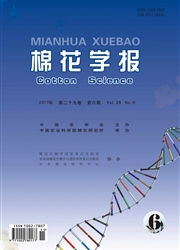

 中文摘要:
中文摘要:
基于农业碳足迹理论及生命周期评价法,采用问卷调查方式,定量研究河北省棉花生产碳足迹,分析其构成因素,解析河北省棉花生产肥料和灌溉投入与产量的关系。研究结果表明:1)河北省棉花生产单位面积、单位产量、单位生物量、单位产值碳足迹(以CO2当量计)分别为3272.7lkg·hm^-1,1.04kg·kg^-1,O.40kg·kg^-1和0134k·¥^-1,低干前人研究结果中华北平原作物生产平均碳足迹和冬小麦碳足迹;2)化肥、灌溉、地膜为河北省棉花生产碳排放主要来源,分别占棉花生产碳足迹的34.53%、25.98%和18.44%;3)在调研的棉田中.25.63%的地块肥料投入过量,21.11%的地块灌溉投入过量,且产量较低,存在着较大的节能减排潜力。逐步扩大棉花种植面积,并发展棉花节肥、节水、免覆膜技术,必将成为未来河北省作物生产应对气候变化,发展低碳农业的重要举措。
 英文摘要:
英文摘要:
Based on farmer's production survey data from Hebei Province, the carbon footprint of cotton production in Hebei Province was estimated using a life-cycle assessment method in the agricultural sector. The proportions of different agricultural inputs in the carbon footprint of cotton production was explored. In addition, the relationships between fertilizer and irrigation inputs and the cotton yield output was analyzed. The results were as follows: 1) the carbon footprint per unit sown area, carbon footprint per unit yield, carbon footprint per unit biomass and carbon footprint per unit production value for cotton production in Hebei Province were 3272.71 kg·hm^-2, 1.04 kg·kg^01 0.40 kg.kg^-1 and 0.34 kg·¥^-1 respectively. The carbon footprint of cot- ton production was lower than that of winter wheat; 2) the main components of the carbon footprint were fertilizer(34.53%), electricity for irrigation (25.98%) and plastic film (18.44%); and 3) in this study, 25.63% of a field exposed to excessive fertilizer and 21.11% of a field exposed to excessive irrigation showed low yields. Thus, there were large energy savings and emission re- duction potentials. Gradually expanding the cotton planting area and developing technology that limits water and fertilizer con- sumption, as well as eliminating plastic film during mulching, could help to mitigate greenhouse gas emissions from agricultural production of Hebei Province.
 同期刊论文项目
同期刊论文项目
 同项目期刊论文
同项目期刊论文
 期刊信息
期刊信息
